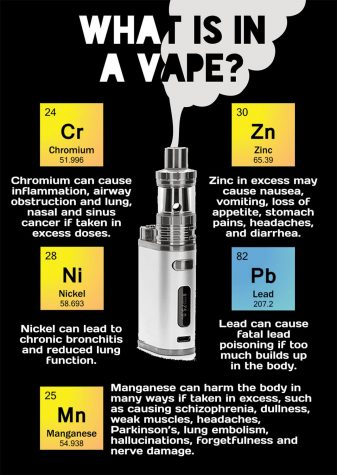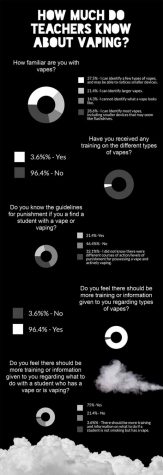Vaping: A Dangerous Epidemic
Vaping has become a widespread epidemic amongst teenagers and now it has diffused to Millard West
December 19, 2018
TEENAGE VAPING
Vaping has infiltrated its way into high schools and is wildly popular amongst teenagers, overtaking cigarette use as the number one health risk facing adolescents today.
According to the Center for Disease Control (CDC), 1.7 million teenagers use vapes daily, and even more alarming, the lack of knowledge these students have on its content.
A study from the National Institute on Drug Abuse found 13.2% thought nicotine was the only ingredient in vapes, 5.8% said marijuana, 13.7% had no idea and 66.0% said the only substance in vapes was flavoring. The actual contents are much more dangerous.
“At first, the appeal was that my friends were doing it,” a Millard West student said. “I didn’t think it was cool, but it was just something to do. It’s something I choose to do, but I don’t know why. I thought it would maybe take a month to stop.”
Similar mindsets to this have led organizations around the United States to combat underage use of vapes.
“We see clear signs that youth use of electronic cigarettes has reached an epidemic proportion, and we must adjust certain aspects of our comprehensive strategy to stem this clear and present danger,” Food and Drug Administration chief Scott Gottlieb said, per NBC News.
This epidemic has posed a massive issue to the FDA and other anti-vaping organizations.
“E-cigs have become an almost ubiquitous and dangerous trend among teens. The disturbing and accelerating trajectory of use we’re seeing in youth, and the resulting path to addiction, must end. It’s simply not tolerable. I’ll be clear. The FDA won’t tolerate a whole generation of young people becoming addicted to nicotine as a trade-off for enabling adults to have unfettered access to these same products,” Gottlieb stated in a report on September 12, 2018.
It is true many teenagers are now hooked on vaping, shown by a study done by the Centers for Disease Control and Prevention.
“In 2017, 19.6% of high school students (estimated 2.95 million users) reported current use of any tobacco product, including 9.2% (1.38 million; 46.8% of current tobacco product users) who currently used ≥2 tobacco products, and 12.9% (1.94 million; 65.8% of current tobacco product users) who currently used any combustible tobacco product (Table). E-cigarettes were the most commonly used tobacco product among high school students (11.7%),” the study stated.
According to the National Center for Education Statistics, there are 15.1 million students attending public high schools in 2018. This would equate to roughly 1.7 million high school students currently using vapes and with the increase in popularity over the last year that number has certainly risen.
The reason why the FDA is so concerned with youth vaping is that they know most students do not understand the substances in vapes.
A study done by the National Institute on Drug Abuse polled high school students and many of them did not know the actual ingredients used in vapes.
HEALTH
Nicotine is an extremely addictive substance. JUUL.com does state its products contain it, but leaves out how addictive it really is.
NBC News published an article in March 2018, which stated, “One Juul ‘pod,’ the nicotine cartridge inserted into the smoking device and heated, delivers about 200 puffs, about as much nicotine as a pack of cigarettes, according to the product website.”
According to a clinical pediatrics staff member at Boston Children’s Hospital Nicholas Chadi, per Business Insider, “After only a few months of using nicotine [these teens] describe cravings, sometimes intense ones. Sometimes they also lose their hopes of being able to quit. After only a few hundred cigarettes – or whatever the equivalent amount of vaping pods – some start showing irritability or shakiness when they stop.”
Nicotine addiction may not seem incredibly harmful on its own, but the added chemicals in vapes make vaping dangerous.
Business Insider also stated in a February 2018 article, “They [a group of researchers from medical schools from all over the world] also found potentially unsafe levels of several other dangerous substances such as arsenic, chromium, and manganese.” The article also stated, “In fact, users appear to be inhaling toxic substances like lead, nickel, chromium and manganese in concentrations that either approached, met, or exceeded the limits defined as safe by the Environmental Protection Agency. Consistently inhaling high levels of these metals has been tied to health problems in the lungs, liver, immune system, heart and brain, as well as some cancers, according to the US Department of Labor’s Occupational Health and Safety Administration.”

Chromium can cause inflammation, airway obstruction and lung, nasal and sinus cancer if taken in excess doses. Lead can cause fatal lead poisoning if too much builds up in the body and nickel can lead to chronic bronchitis and reduced lung function. Manganese can harm the body in many ways if taken in excess, such as causing schizophrenia, dullness, weak muscles, headaches, Parkinson’s, lung embolism, hallucinations, forgetfulness and nerve damage.
These toxic chemicals can harm the body if too much is taken in. While vaping has not yet been linked to any of these, it is important to note these take time to develop and will not appear after the first few times vaping. That is not to say vaping is not harmful if it is done in minuscule amounts. There is not sufficient research on the full effects vaping has on the human system because it has become prevalent only recently, so some of the effects may pop up in the future.
A catalyst for the uptick in teenagers becoming addicted to a potentially harmful drug is the ads companies like JUUL, who controls 72% of the e-cigarette market, have put out.
The New York Times published an article stating, “Juul recently deleted months of social media posts [It deleted its Facebook and Instagram accounts on November 13, 2018], including ones with images of cool-looking young people vaping Juuls. This spring it made major changes to its website, which had prominently displayed a Juul surrounded by luscious-looking images of fruit and the words ‘Mango, it’s back’ The site is now a more sober-looking affair, featuring video of adults vaping with a tagline ‘For smokers. By design.’”
It is true JUUL has re-branded itself to an adult-oriented product. The website is comprised of blacks, teals, grays and whites instead of boisterous bright colors that would attract younger audiences. The advertisements have also changed from those described by the Times to adults vaping along with close-ups of the product. There is an additional ad at the top of the page directing visitors to their plans to battle teenage vaping.
“We will now make Mango, Fruit, Crème and Cucumber available only on JUUL.com, where we are adding additional age-verification measures to an already industry-leading online sales system that is restricted to people 21+ and utilizes third party verification,” the report states. “To complete an order at JUUL.com, users are asked to provide their name, date of birth, permanent address and the last four digits of their social security number.”
The report also states bulk shipments will be halted to prevent distribution to minors. Customers can only purchase two devices and 15 JUUL pods per month and no more than 10 JUULs per year.
However, upon closer inspection, there are visible cracks in JUUL’s plan to halt teen vaping.
While minors can no longer directly buy flavored JUUL pods or devices online, they can still obtain them through other means (not to mention Suorin vapes have no regulations online other than a pop-up that can be easily dismissed). Most notably, they can receive them from upperclassmen peers who are legally allowed to buy devices in retail stores, where the age for buying vape products is 18 in Nebraska. These regulations have also just been put out recently, meaning teenagers have owned vapes for much longer than these rules have been in place and will continue to possess them.

The report also fails to mention the mint flavor will not be affected by the blocks of other flavors. JUUL is giving teenagers a tastier option than generic tobacco pods.
In addition, the website has noticeable flaws in its promise to appeal to adults only. There are many sentiments such as, “JUUL is designed with smokers in mind, from form to technology to flavor. It is easy to use, no buttons or switches” and “JUUL provides satisfaction to meet the standards of smokers looking to switch from smoking cigarettes” that are targeted at a universal audience regardless of age.
The website gloats about its flavoring ingredients with statements such as, “Our JUULsalts e-liquid contains a proprietaryormulation that combines glycerol, propylene glycol, natural oils, extracts and flavor, nicotine and benzoic acid. Together with temperature-regulated vapor technology, this proprietary chemistry enables JUUL to deliver a vapor experience like no other.”
Obviously, this is essential in attracting customers for any business; however, it describes JUULs as a high tech, easy to use and flavorful vaping device. It may state its mission is to assist adult smokers, but, regardless of the lack of color and restrictions on purchases, the website still sends a message to teenagers visiting the site that JUUL is a unique satisfying product. It adds to the diffusion of vapes around the country, especially to schools. Millard West is no exception.
MILLARD WEST
“There are serious consequences to those who vape and to those who surround themselves with people who vape,” senior Majd Nuwarah said. “Vaping is still dangerous. Just because it tastes like crème brulee does not mean it’s crème brulee. I am sick of people who think any substance that alters your body negatively is okay. It’s stupid and ignorant for someone to vape, especially in a public government owned building.”
A problem so massive among the student body has posed a new challenge to West’s administration.
“One thing our security staff is really trying to sweep through the bathrooms regularly to keep kids out of there and keep them from vaping,” assistant principal Stacy Longacre said. “We have confiscated lots of vapes, more this year than last year. The devices are getting smaller and looking like other items a person would have and they are easier to conceal. We know what’s going on. Obviously, we can’t pat search or strip search people. We do our best to search them and their belongings. Just trying to be vigilant and having adult presence to try to deter them.”
Longacre said there were 30-40 cases of vaping in the building this year. The school is catching some students vaping, however there are far more students who are not being found. Even when administration finds people vaping, the punishment is minimal.
“Typically our suspensions have been when we caught students in classrooms using it,” Longacre said. “We have gone with detentions if they are in possession or we are sweeping out the bathrooms.”
Suspending students who vape in classrooms is an appropriate punishment, however far more vape in the bathrooms. Detentions are not just punishments for possessing an illegal substance in school. It should be noted, however, that the consequences of vaping varies from district to district. Carroll County Public Schools in Maryland starts off with a session of Saturday School for the first offense and then dishes out lengthier suspensions for repeated suspensions and St. Clairsville Middle School in Ohio added offenses to students’ criminal records. These punishments vary from a slap on the wrist to treating students as criminals.
Millard is trying out a new punishment system following Winter Break.
“After the first of the year, any possession of any vaping product will be a 2-3 day suspension,” Longacre said. She added repeated offenses may result in expulsion.
This system will provide appropriate punishments, however an issue will still be catching students.
A poll was sent out to teachers around the building asking about the level of training they have received on vaping and their level of knowledge of vaping devices.

“We need to have a clear cut policy regarding this, one that administration will follow through without deviating from the outline consequences,” one response said. “We need to be consistent. We also need to be monitoring the bathrooms more and not letting students out of the lunchroom when they shouldn’t be in the hallways. This problem has now seeped into my classroom and is disrupting the environment in my classroom to the point where I can’t always teach my lessons as they are planned.”
It is clear many teachers do not fully understand vaping devices. While most receive emails, they almost all call for more information on what vapes look like and how to deal with students possessing them. They care about being able to assist the administration in eliminating vapes from Millard West, but currently some do not have sufficient information to deal with the problem.
In addition, the publicity to inform students about the dangers of vaping have been minimal. Currently, there are only three posters in the entire school, two of them being the same. Many more were put up originally, but students have taken these down and disposed of them. There are no other forms of publicity regarding the dangers of vaping in the school outside of health classes. There is no information on the epidemic during the morning and at lunch on the screen wall, nor at assemblies or during Quad QT.
West does provide help for students addicted to vaping through counselors, however many students will not talk to their counselor due to not wanting to be caught for vaping. A longer suspension and chance of expulsion may deter students from mentioning their use of the drug to any faculty member. This is especially a problem when they may use vapes to deal with anxiety or stress at school or home. They may need help dealing with it in other ways than harmful drugs.
The challenge for West is to institute a system that will punish students appropriately for vaping while also not deterring them from receiving help from the school.
Though the current rules and tactics are light, the end of Winter Break may serve as a shift to a school that informs teachers, punishes students accordingly, heavily advertises the health effects of vaping and assists students who desire addiction help. The school is cracking down on vaping soon and the prevalence of vaping in Millard West may change quickly. It is essential to try to curb the widespread use of this harmful drug amongst teenagers.

















